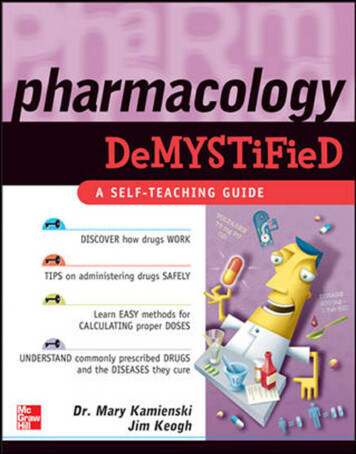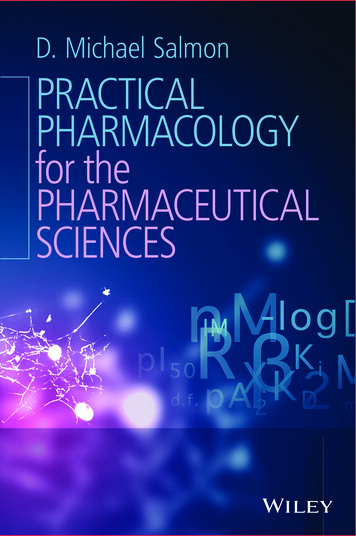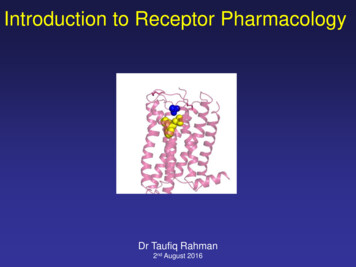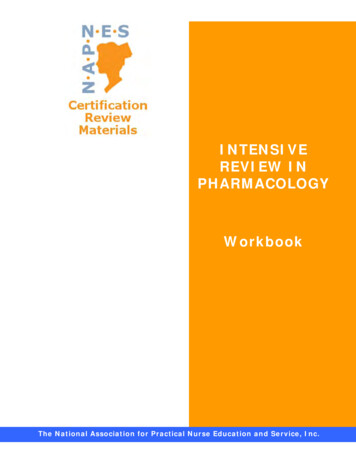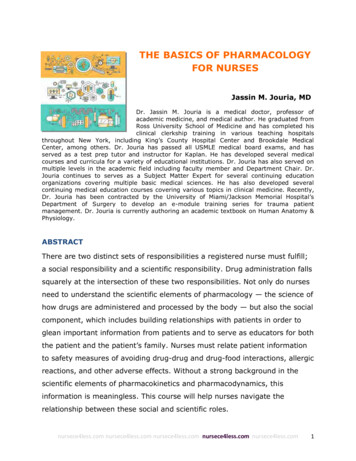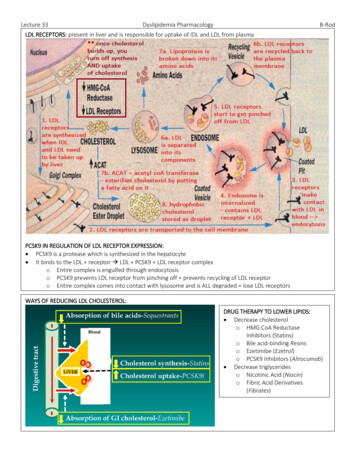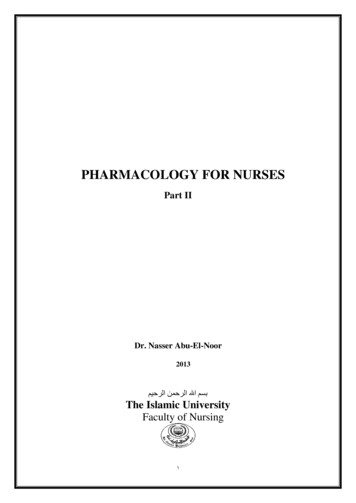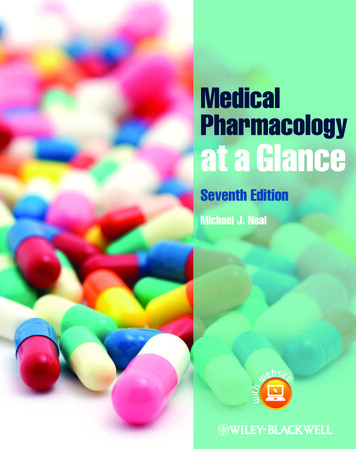
Transcription
MedicalPharmacologyat a GlanceMichael J. NealEmeritus Professor of PharmacologyKing’s College LondonLondonSeventh EditionA John Wiley & Sons, Ltd., Publication
This edition first published 2012 2012 by John Wiley & Sons, Ltd.Wiley-Blackwell is an imprint of John Wiley & Sons, formed by the merger of Wiley’s global Scientific,Technical and Medical business with Blackwell Publishing.Registered office:PO19 8SQ, UKJohn Wiley & Sons, Ltd, The Atrium, Southern Gate, Chichester, West Sussex,Editorial offices:9600 Garsington Road, Oxford, OX4 2DQ, UKThe Atrium, Southern Gate, Chichester, West Sussex, PO19 8SQ, UK111 River Street, Hoboken, NJ 07030-5774, USAFor details of our global editorial offices, for customer services and for information about how to applyfor permission to reuse the copyright material in this book please see our website at www.wiley.com/wiley-blackwellThe right of the author to be identified as the author of this work has been asserted in accordance withthe UK Copyright, Designs and Patents Act 1988.All rights reserved. No part of this publication may be reproduced, stored in a retrieval system, ortransmitted, in any form or by any means, electronic, mechanical, photocopying, recording or otherwise,except as permitted by the UK Copyright, Designs and Patents Act 1988, without the prior permission ofthe publisher.Designations used by companies to distinguish their products are often claimed as trademarks. All brandnames and product names used in this book are trade names, service marks, trademarks or registeredtrademarks of their respective owners. The publisher is not associated with any product or vendormentioned in this book. This publication is designed to provide accurate and authoritative information inregard to the subject matter covered. It is sold on the understanding that the publisher is not engaged inrendering professional services. If professional advice or other expert assistance is required, the servicesof a competent professional should be sought.The contents of this work are intended to further general scientific research, understanding, anddiscussion only and are not intended and should not be relied upon as recommending or promoting aspecific method, diagnosis, or treatment by physicians for any particular patient. The publisher and theauthor make no representations or warranties with respect to the accuracy or completeness of thecontents of this work and specifically disclaim all warranties, including without limitation any impliedwarranties of fitness for a particular purpose. In view of ongoing research, equipment modifications,changes in governmental regulations, and the constant flow of information relating to the use ofmedicines, equipment, and devices, the reader is urged to review and evaluate the information providedin the package insert or instructions for each medicine, equipment, or device for, among other things,any changes in the instructions or indication of usage and for added warnings and precautions. Readersshould consult with a specialist where appropriate. The fact that an organization or website is referred toin this work as a citation and/or a potential source of further information does not mean that the authoror the publisher endorses the information the organization or website may provide or recommendationsit may make. Further, readers should be aware that internet websites listed in this work may havechanged or disappeared between when this work was written and when it is read. No warranty may becreated or extended by any promotional statements for this work. Neither the publisher nor the authorshall be liable for any damages arising herefrom.Library of Congress Cataloging-in-Publication DataMedical pharmacology at a glance / Michael J. Neal. – 7th ed.p. ; cm. – (At a glance series)Includes bibliographical references and index.ISBN-13: 978-0-470-65789-8 (pbk. : alk. paper)ISBN-10: 0-470-65789-8I. Title. II. Series: At a glance series (Oxford, England)[DNLM: 1. Pharmacology, Clinical. QV 38]LC classification not assigned615'.1–dc232011034157A catalogue record for this book is available from the British Library.Set in 9 on 11.5 pt Times by Toppan Best-set Premedia Limited12012
PrefaceThis book is written primarily for medical students but it should alsobe useful to students and scientists in other disciplines who would likean elementary and concise introduction to pharmacology.In this book the text has been reduced to a minimum for understanding the figures. Nevertheless, I have attempted in each chapter toexplain how the drugs produce their effects and to outline theiruses.In this seventh edition the chapters have been updated and a newchapter on immunosuppressants has been added.AcknowledgementsI am grateful to Professor J.M. Ritter, Professor M. Marbur andProfessor P.J. Ciclitira for their advice and helpful comments on thecase studies relevant to their special interests.How to use this bookEach of the chapters (listed on page 5) represents a particular topic,corresponding roughly to a 60-minute lecture. Beginners in pharmacology should start at Chapter 1 and first read through the text on theleft-hand pages (which occasionally continues to the facing right-handpage above the ruled line) of several chapters, using the figures onlyas a guide.Once the general outline has been grasped, it is probably better toconcentrate on the figures one at a time. Some are quite complicatedand certainly cannot be taken in ‘at a glance’. Each should be studiedcarefully and worked through together with the legends (righthand pages). Because many drugs appear in more than one chapter,considerable cross-referencing has been provided. As progress ismade through the book, use of this cross-referencing will providevaluable reinforcement and a greater understanding of drugaction. Once the information has been understood, the figures shouldsubsequently require little more than a brief look to refresh thememory.The figures are highly diagrammatic and not to scale.Further readingBritish National Formulary. British Medical Association and TheRoyal Pharmaceutical Society of Great Britain, London (about1000 pp). The BNF is updated twice a year.Rang, H.P., Dale, M.M., Ritter, J.M., Flower, R.J. & Henderson, G.(2011) Pharmacology, 7th edn, Churchill Livingstone, Edinburgh(829 pp).Bennett, P.N. & Brown, M.J. (2008) Clinical Pharmacology, 10th edn,Churchill Livingstone, Edinburgh (694 pp).Further reading 7
1Introduction: principles of drug rinedopamineserotoninγ-aminobutyricacid (GABA)glutamateA few drugsblock sisEnzymesStorageSome drugs inhibitenzymesacetylcholinesteraseHMG-CoA reductasemonoamine oxidasecyclo-oxygenasethymidine kinasephosphorylationof enzymeschannels,other ronetestosteroneestradiolhistamineserotonin gradationReceptorchannelcomplexPhospholipase CSecondmessengersCa2 Some drugs inhibittransport processesCouplingG-proteins PIP2InsP3DGION CHANNELSAdenylyl cyclaseCellular response–ATPcAMPK Protein kinasesMedical pharmacology is the science of chemicals (drugs) thatinteract with the human body. These interactions are divided into twoclasses: pharmacodynamics – the effects of the drug on the body; and pharmacokinetics – the way the body affects the drug with time(i.e. absorption, distribution, metabolism and excretion).The most common ways in which a drug can produce its effects areshown in the figure. A few drugs (e.g. activated charcoal, osmoticdiuretics) act by virtue of their physicochemical properties, and this iscalled non-specific drug action. Some drugs act as false substrates orinhibitors for certain transport systems (bottom right) or enzymes(bottom left). However, most drugs produce their effects by acting onspecific protein molecules, usually located in the cell membrane.These proteins are called receptors ( ), and they normally respondto endogenous chemicals in the body. These chemicals are eithersynaptic transmitter substances (top left, ) or hormones (top right,). For example, acetylcholine is a transmitter substance released from8PReleaseMany drugsactivate (agonists) orblock E BLOCKERSENZYME INHIBITORSEndocrine gland cellPrecursoruptakeP–HormonesSome drugsinhibit thefollowingNerve terminals–Ca2 channels(Ca channel blockers)Na channels(local anaesthetics)KATP channels(oral antidiabetics)ACTIVE TRANSPORTNa /K -ATPase(cardiac glycosides)Na motor nerve endings; it activates receptors in skeletal muscle, initiating a sequence of events that results in contraction of the muscle.Chemicals (e.g. acetylcholine) or drugs that activate receptors andproduce a response are called agonists ( ). Some drugs, called antagonists ( ), combine with receptors, but do not activate them.Antagonists reduce the probability of the transmitter substance (oranother agonist) combining with the receptor and so reduce or blockits action.The activation of receptors by an agonist or hormone is coupled tothe physiological or biochemical responses by transduction mechanisms (lower figure) that often (but not always) involve moleculescalled ‘second messengers’ ( ).The interaction between a drug and the binding site of the receptordepends on the complementarity of ‘fit’ of the two molecules. Thecloser the fit and the greater the number of bonds (usually noncovalent), the stronger will be the attractive forces between them, and thehigher the affinity of the drug for the receptor. The ability of a drugMedical Pharmacology at a Glance, Seventh Edition. Michael J. Neal. 2012 John Wiley & Sons, Ltd. Published 2012 by John Wiley & Sons, Ltd.
to combine with one particular type of receptor is called specificity.No drug is truly specific, but many have a relatively selective actionon one type of receptor.Drugs are prescribed to produce a therapeutic effect, but they oftenproduce additional unwanted effects (Chapter 46) that range from thetrivial (e.g. slight nausea) to the fatal (e.g. aplastic anaemia).ReceptorsThese are protein molecules that are normally activated by transmittersor hormones. Many receptors have now been cloned and their aminoacid sequences determined. The four main types of receptor are listedbelow.1 Agonist (ligand)-gated ion channels are made up of protein subunitsthat form a central pore (e.g. nicotinic receptor, Chapter 6; γaminobutyric acid (GABA) receptor, Chapter 24).2 G-protein-coupled receptors (see below) form a family of receptorswith seven membrane-spanning helices. They are linked (usually) tophysiological responses by second messengers.3 Nuclear receptors for steroid hormones (Chapter 34) and thyroidhormones (Chapter 35) are present in the cell nucleus and regulatetranscription and thus protein synthesis.4 Kinase-linked receptors are surface receptors that possess (usually)intrinsic tyrosine kinase activity. They include receptors for insulin,cytokines and growth factors (Chapter 36).Transmitter substances are chemicals released from nerve terminals that diffuse across the synaptic cleft and bind to the receptors.This binding activates the receptors by changing their conformation,and triggers a sequence of postsynaptic events resulting in, forexample, muscle contraction or glandular secretion. Following itsrelease, the transmitter is inactivated (left of figure) by either enzymicdegradation (e.g. acetylcholine) or reuptake (e.g. norepinephrine[noradrenaline], GABA). Many drugs act by either reducing orenhancing synaptic transmission.Hormones are chemicals released into the bloodstream; theyproduce their physiological effects on tissues possessing the necessaryspecific hormone receptors. Drugs may interact with the endocrinesystem by inhibiting (e.g. antithyroid drugs, Chapter 35) or increasing(e.g. oral antidiabetic agents, Chapter 36) hormone release. Otherdrugs interact with hormone receptors, which may be activated (e.g.steroidal anti-inflammatory drugs, Chapter 33) or blocked (e.g. oestrogen anta-gonists, Chapter 34). Local hormones (autacoids), such ashistamine, serotonin (5-hydroxytryptamine, 5HT), kinins and prostaglandins, are released in pathological processes. The effects of histamine can sometimes be blocked with antihistamines (Chapter 11), anddrugs that block prostaglandin synthesis (e.g. aspirin) are widely usedas anti-inflammatory agents (Chapter 32).Transport systemsThe lipid cell membrane provides a barrier against the transport ofhydrophilic molecules into or out of the cell.Ion channels are selective pores in the membrane that allow theready transfer of ions down their electrochemical gradient. The open–closed state of these channels is controlled either by the membranepotential (voltage-gated channels) or by transmitter substances (ligand-gated channels). Some channels (e.g. Ca2 channels in the heart)are both voltage and transmitter gated. Voltage-gated channels forsodium, potassium and calcium have the same basic structure (Chapter5), and subtypes exist for each different channel. Important examplesof drugs that act on voltage-gated channels are calcium-channel block-ers (Chapter 16), which block L-type calcium channels in vascularsmooth muscle and the heart, and local anaesthetics (Chapter 5),which block sodium channels in nerves. Some anticonvulsants(Chapter 25) and some antiarrhythmic drugs (Chapter 17) also blockNa channels. No clinically useful drug acts primarily on voltage-gatedK channels, but oral antidiabetic drugs act on a different type of K channel that is regulated by intracellular adenosine triphosphate (ATP,Chapter 36).Active transport processes are used to transfer substances againsttheir concentration gradients. They utilize special carrier molecules inthe membrane and require metabolic energy. Two examples are listedbelow.1
This book is written primarily for medical students but it should also be useful to students and scientists in other disciplines who would like an elementary and concise introduction to pharmacology. In this book the text has been reduced to a minimum for understand-ing the figures. Nevertheless, I have attempted in each chapter to Further reading Rang, H.P., Dale, M.M., Ritter, J.M., Flower .

